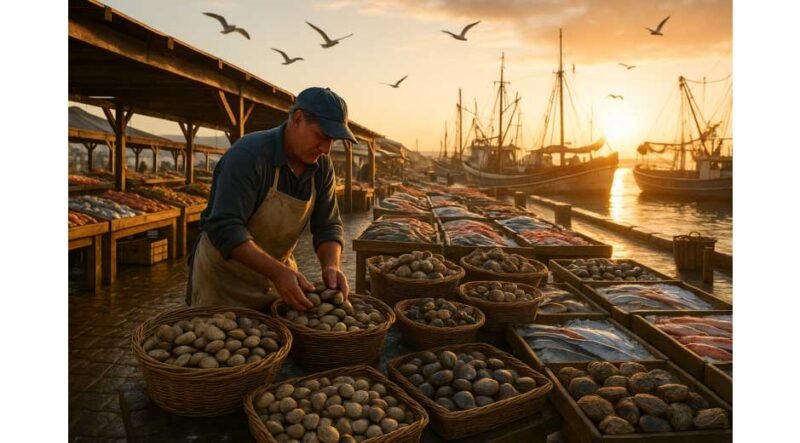Travel often carries us beyond landscapes and monuments, drawing us into the very kitchens and marketplaces that define a place. Along the coastlines where ocean breezes shape the rhythm of daily life, food is more than sustenance—it is a cultural signature. From bustling harbor towns to quiet fishing villages, the relationship between people and the sea reveals itself most vividly on the plate. When you sit down at a seaside café or wander through a waterfront market, you step into centuries of tradition shaped by the ebb and flow of the tide.
Food as a Coastal Compass
Every shoreline tells its own story, and food becomes a compass to navigate it. In New England, for instance, travelers encounter creamy chowders that comfort against the chill of the Atlantic winds. Across the Pacific Northwest, rustic seafood shacks line the coast, serving steamed shellfish and ocean-fresh fish that celebrate abundance. Beyond the familiar tourist attractions, these coastal experiences connect visitors to the deeper character of the region.
Sampling local dishes is not merely about flavor—it’s about insight. It’s about tracing the journey from ocean to table and appreciating the craft of those who harvest, sort, and prepare the bounty of the sea. This awareness gives travelers a richer sense of place, linking taste to tradition in a way that lingers long after the trip has ended. For those who wish to immerse themselves fully, understanding different clam sizes can reveal just how much subtlety and heritage reside in even the simplest dish.
Markets as Cultural Gateways
Seaside markets remain among the most dynamic windows into coastal life. Stalls brim with oysters on crushed ice, freshly netted fish laid out with shimmering scales, and baskets of clams stacked by the hundreds. Each display reflects not only the day’s catch but also the historical patterns of trade, consumption, and local preference.
Visitors often find themselves struck by the range of seafood options, but markets also speak to values of sustainability and stewardship. Coastal communities are deeply aware that their livelihoods depend on the careful balance between harvest and preservation. These marketplaces, alive with bargaining voices and the clatter of shells, embody the intersection of economy, ecology, and culture.
To pause at a vendor’s stall and ask about preparation methods is to receive more than culinary advice—it is an invitation into the narrative of a region. What may seem like a casual exchange is, in truth, a small act of cultural preservation, passing stories and traditions from one generation to the next.
Dining by the Water’s Edge
If markets are the stage, then coastal restaurants are the performance. Imagine a small bistro overlooking the harbor, where the menu changes daily based on what the boats bring in. The air carries the scent of the sea, mingling with the aromas of garlic, butter, and herbs. Diners hear the chatter of gulls and the slap of waves against the pier, grounding the culinary experience in its natural context.
Travelers quickly realize that dining by the water is not simply about what is on the plate but also where it is consumed. The physical environment—the wooden pier, the weathered table, the salty breeze—becomes an integral ingredient in the meal itself. These layers of sensory experience are what make coastal cuisine so memorable.
The Subtleties of the Sea
Though seafood may be served with casual ease, the preparation often rests on centuries of accumulated knowledge. The delicate task of pairing shellfish with specific cooking methods requires skill and sensitivity. A dish of steamed clams, for example, differs greatly from a baked casserole or a rustic stew. Appreciating these nuances helps travelers recognize the artistry embedded in what might appear to be a simple seaside meal.
The variety extends beyond preparation—it lies in the seafood itself. Local chefs and fishmongers alike will emphasize that not all shellfish are created equal. In fact, the size and age of clams can dictate their ideal use in cooking, affecting both flavor and texture. For the traveler curious about culinary authenticity, understanding different clam sizes becomes a way of decoding the menu and appreciating the depth of regional cooking traditions.
Learning Through Travel
One of the most rewarding aspects of travel is the chance to learn by doing. Tasting a dish after hearing the story behind it elevates the experience from ordinary dining to cultural immersion. This is especially true in coastal settings, where the distance between the sea and the table is often only a few steps.
Guided tours of fishing harbors, visits to aquaculture farms, and cooking workshops with local chefs offer opportunities for travelers to deepen their appreciation. These encounters bridge the gap between visitor and resident, turning a simple meal into a meaningful exchange. Such experiences not only enrich travel but also encourage more mindful choices about seafood consumption and sustainability back home.
Memory in a Meal
Food memories anchor travel experiences. Years after a trip, travelers often recall the taste of a particular meal with vivid clarity. A bowl of clam chowder shared with locals on a foggy morning, or grilled shellfish eaten at sunset on a dock, can embody the essence of an entire journey.
These culinary snapshots become souvenirs, often more enduring than photographs or trinkets. They represent the lived reality of a place, capturing not just its sights but its flavors and textures. Coastal cuisine, with its emphasis on freshness and place-specific character, excels in creating such indelible impressions.
Conclusion: Travel Through Taste
To travel along the world’s coastlines is to journey through a tapestry woven from both sea and soil. Markets, restaurants, and communal meals form the threads that bind these experiences together, allowing visitors to connect deeply with the regions they explore. Beyond scenic views and sandy beaches, it is the interplay of tradition, taste, and environment that defines coastal travel.
For those who seek more than surface impressions, embracing the culinary culture of the sea opens a pathway to authentic discovery. Every shell, every plate, every shared story is a reminder that travel is not only about where you go but also about what you taste, learn, and carry forward.









